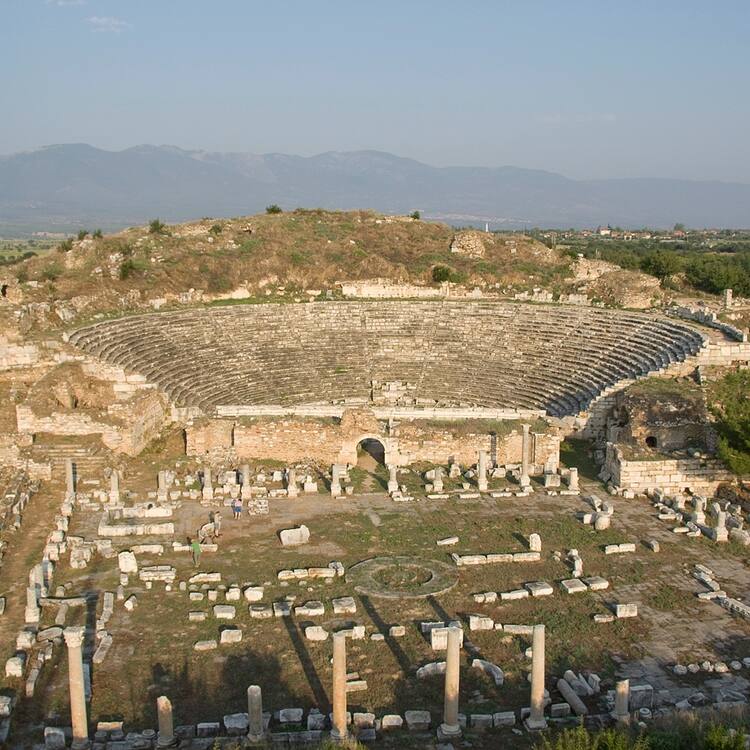Aphrodisias
Aphrodisias
Located in southwestern Turkey, in the upper valley of the Morsynus River, the site consists of two components: the archaeological site of Aphrodisias and the marble quarries northeast of the city. The temple of Aphrodite dates from the 3rd century BC and the city was built one century later. The wealth of Aphrodisias came from the marble quarries and the art produced by its sculptors. The city streets are arranged around several large civic structures, which include temples, a theatre, an agora and two bath complexes.
Description is available under license CC-BY-SA IGO 3.0
Aphrodisias
Situé au sud-ouest de la Turquie, dans la vallée supérieure de la rivière Morsynus, ce site comprend deux éléments : le site archéologique d’Aphrodisias et les carrières de marbre situées au nord-est de la ville. Le temple d’Aphrodite date du IIIe siècle avant notre ère. La cité d’Aphrodisias a été construite un siècle plus tard. La richesse de la ville provenait des carrières de marbre et de l’art produit par les sculpteurs de la ville. Les rues de la cité s’organisent autour de grandes structures municipales, notamment des temples, un théâtre, une agora et deux édifices thermaux.
Description is available under license CC-BY-SA IGO 3.0
أفروديسياس
تقع مدينة أفروديسياس جنوب غرب تركيا في الوادي الذي يعلو نهر مورسينوس، ويضم الموقع عنصرين اثنين هما موقع أفروديسياس الأثري ومحاجر الرخام الكائنة شمال شرق المدينة. هذا ويعود معبد أفروديت للقرن الثالث قبل الميلاد. وتجدر الإشارة إلى أنّ مدينة أفروديسياس بنيت بعد قرن من ذلك. وتعود أهميّة أفروديسياس إلى محاجر الرخام وفنون النحت فيها. وقد شيّدت شوارع المدينة حول عدد من المنشآت المدنيّة الرئيسة مثل المعابد والمسرح والأغورا والحمامات.
source: UNESCO/CPE
Description is available under license CC-BY-SA IGO 3.0
Afrodisias
Situado al sudoeste de Turquía, en el alto valle del río Morsynus, este sitio consta de dos partes: los vestigios arqueológicos de Afrodisias y las canteras de mármol situadas al nordeste de esta antigua ciudad. La construcción del templo dedicado a Afrodita se inició probablemente en el siglo III a.d.C. y la de la ciudad un siglo después. Afrodisias, prosperó gracias a sus cercanas canteras de mármol y al arte consumado de sus escultores. Las calles de la ciudad están organizadas en torno a varias amplias estructuras cívicas que incluyen templos, un teatro, un ágora y dos complejos termales.
source: UNESCO/CPE
Description is available under license CC-BY-SA IGO 3.0
Aphrodisias
In de bovenvallei van de Morsynus rivier in Zuidwest-Turkije ligt de werelderfgoedsite Aphrodisias. De site bestaat uit twee componenten. Enerzijds de archeologische site van Aphrodisias, anderzijds de marmergroeven ten noorden van de stad. De tempel van Aphrodite dateert uit de 3e eeuw voor Christus. De stad werd een eeuw later gebouwd. De rijkdom van Aphrodisias kwam door de nabij gelegen marmergroeven en de kunst die door haar beeldhouwers daarvan werd geproduceerd. De straten van de stad zijn langs diverse burgerstructuren gearangeerd, zoals tempels, een theater, een agora en twee badhuiscomplexen.
Source: unesco.nl
Outstanding Universal Value
Brief Synthesis
Aphrodisias is located in southwestern Turkey, in the fertile valley formed by the Morsynus River, in the ancient region of Caria. The serial property consists of two components. The first component encompasses the archaeological site of Aphrodisias following the city walls that encircle the city; and the second component includes the marble quarries located northeast of the city. Aphrodisias was founded as a city-state in the early 2nd century BC. An orthogonal street grid defines the pattern of the city; only a few structures, such as the temple of the goddess Aphrodite, are not aligned with the grid. Because the city shared a close interest in the goddess Aphrodite with Sulla, Julius Caesar and the emperor Augustus, Aphrodisias came to have a close relationship with Rome. It obtained a privileged ‘tax-free’ political status from the Roman senate, and developed a strong artistic, sculptural tradition during the Imperial Period. Many elaborately decorated structures were erected during the period of Roman rule, all made from the local marble.
The Cult of Aphrodite was the most important cult of Aphrodisias. The sanctuary at Aphrodisias had a distinctive cult statue of Aphrodite which defined the city’s identity. The Aphrodite of Aphrodisias combined aspects of a local Anatolian, archaic fertility goddess with those of the Hellenic Aphrodite, goddess of love and beauty. This identifying image has been found from Anatolia across the Mediterranean, from the city of Rome to the Levant. The importance of the Aphrodite of Aphrodisias continued well beyond official imperial acceptance of Christianity; the Temple did not become a church until c. AD 500.
The proximity of the marble quarries to the city was a major reason that Aphrodisias became an outstanding high-quality production centre for marble sculpture. Sculptors from the city were famous throughout the Roman Empire. They were well-known for virtuoso portrait sculpture and Hellenistic-style statues of gods and Dionysian figures. In late antiquity (4th-6th centuries AD), Aphrodisian sculptors were in great demand for marble portrait busts and statues of emperors, governors and philosophers in the major centres of the empire – for example, at Sardis, Stratonikeia, Laodikeia, Constantinople and Rome. In this period they were the best carvers of marble statues of their day. The techniques used, the quality of local artistic design, and the production of advanced portrait sculpture gave Aphrodisias a unique place in the Roman world.
Another key aspect of Aphrodisias was its cosmopolitan social structure (Greek, Roman, Carian, pagan, Jewish, Christian) that is abundantly articulated in the site’s 2,000 surviving inscriptions.
Criterion (ii): The exceptional production of sculpted marble at Aphrodisias blends local, Greek, and Roman traditions, themes and iconography. It is visible throughout the city in an impressive variety of forms, from large decorated architectural blocks to larger than life-size statues to small portable votive figures. The proximity of good quarries with both pure white and grey marbles was a strong catalyst for the swift development of the city as a noted centre for marble-carving and marble-carvers. The ability of Aphrodisian sculptors was sought after in metropolitan Rome where signatures of Aphrodisian sculptors appear on some of the finest surviving works – for example, from Hadrian’s Villa at Tivoli. These sculptors were major participants in the Empire’s art market between the 1st and 5th centuries AD.
Criterion (iii): Aphrodisias occupies a pre-eminent place in the study of sculpture in the Roman world. Its quarries and its sculpture workshops made it a major art centre, famous for the creativity and technical skill of its sculptors. Aphrodisias has one of the very few known and systematically excavated sculpture workshops of the Roman Empire, which provides a fuller understanding of the production of marble sculpture than anywhere else in the Roman world.
Criterion (iv): Aphrodisias is an exceptional example of the built environment of a Greco-Roman city in inland Asia Minor. Several of its monumental marble buildings have unique features in terms of architecture and design. The Sebasteion, an elaborate cult complex for the worship of Augustus and the Julio-Claudian emperors, represents a distinctive integration of Hellenistic, Roman and Aphrodisian artistic traditions. The “Archive Wall” in the theatre is a well-preserved collection of official imperial documents regarding the status of the city under the Empire. The Theatre also features an early example of a stage building with an aediculated façade. The Stadium has an unusual architectural form with two curved ends, known as “amphitheatral”, and is the best-preserved example of this type in the ancient world. The conversion of the Temple of Aphrodite into a cathedral, around AD 500, is unique among temple-to-church conversions in its engineering and transformative effect. The Tetrapylon, the conspicuous entrance to the outer Sanctuary of Aphrodite, is preserved with its elaborate and exquisitely carved architectural ornament.
Criterion (vi): Aphrodisias was famous in antiquity as the cult centre of a version of Aphrodite which amalgamates aspects of an archaic Anatolian fertility goddess with those of the Hellenic goddess of love and beauty. The Aphrodite of Aphrodisias appears in marble figures from the site of Aphrodisias as well as from many other locations around the Mediterranean. This dissemination of the cult image is strong evidence of the regional and supra-regional importance of the cult.
Integrity
The property includes all elements necessary to express its values and has not suffered from significant geomorphological change or intensive human occupation since antiquity. The limits of the property ensure full representation of the attributes conveying the Outstanding Universal Value of both the city and the marble quarries. The property has been legally taken under control by the State, and appropriate policies and actions have been proposed within the conservation and management plans in order to sustain the integrity of the site.
Authenticity
The authenticity of the serial property is established through its quarries, monuments and sculptures, about 2,000 surviving inscriptions, a comprehensively studied history and a substantial body of published research. The work of conservation and restoration at Aphrodisias has been undertaken in conformity with the Charter of Venice, respecting their original designs and building materials. The landscape surrounding Aphrodisias has not been exposed to modern development or to mass tourism.
Protection and management requirements
Legal protection of the property has been provided by the Act on the Conservation of Cultural and Natural Property No. 2863 since 1978 for the ancient city and since 1981 for the quarries. By the decision No. 5580 of the Aydin Regional Conservation Council in 2016, legal protection has been strengthened for the quarries. Legal protection should be extended for the entirety of the buffer zone. The patrols by the local gendarmerie should be expanded in order to include the quarry component as well as the buffer zone.
The Ministry of Culture and Tourism with its central and local branches and the excavation team are the main bodies responsible for the conservation, protection, promotion and management of the site. Integration of the local community into the management system of the property needs to be strengthened.
The archaeological site is excavated, researched and conserved by the excavation team which is authorized by the government on an annual basis, and its work is regularly monitored by the Ministry of Culture and Tourism.
A Conservation Plan for the city component was prepared, and approved by the Aydin Regional Conservation Council in 2002. A full 3D inventory of the quarry faces should be conducted in order to provide a baseline record of their condition. There is a need for formulation and implementation of monitoring indicators for the quarry component as well as implementation of remedial conservation measures.
The Aphrodisias Management Plan, prepared under the supervision of the Ministry of Culture and Tourism with the support of Geyre Foundation, was approved on 17 September 2013 and its implementation is followed by the Advisory Board and the Supervision and Coordination Board, as well as the site manager appointed by the Ministry of Culture and Tourism. Both the conservation and management plans should be updated to reflect the extent of the property at the time of inscription.
Flooding in winter and wildfire in summer are the major natural risks to the property. For the prevention of flooding, a drainage plan within the walled city should be quickly implemented.
Also, a fire response plan and training in fire suppression should be developed. Mobile water tanks should be placed within the city during the summer as an interim measure until a permanent fire suppression system is installed.

